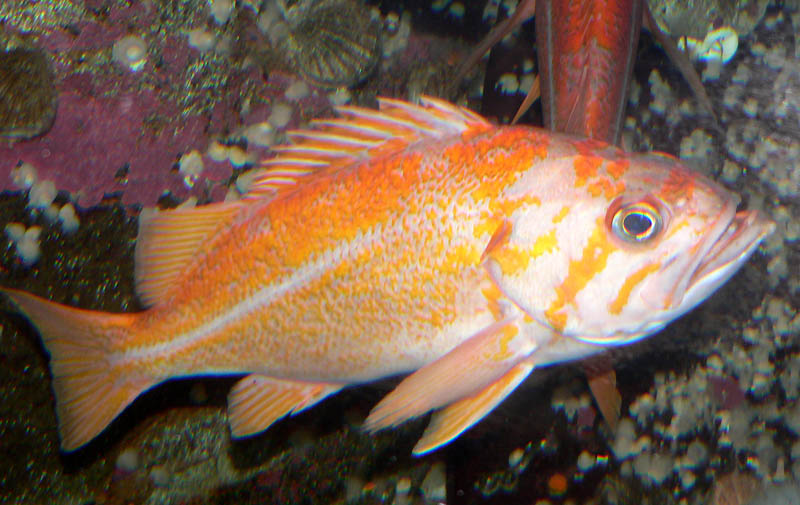- Canary rockfish
Taxobox
name = Canary rockfish

image_width = 250px
image_caption = "Sebastes pinniger" at the Vancouver Aquarium
regnum =Animal ia
phylum = Chordata
classis =Actinopterygii
ordo =Scorpaeniformes
familia =Sebastidae
genus = "Sebastes "
species = "S. pinniger"
binomial = "Sebastes pinniger"
binomial_authority = Gill,1864 The canary rockfish ("Sebastes pinniger") is a
rockfish of the Pacific coast, found from south ofShelikof Strait in the easternGulf of Alaska toPunta Colnett in northernBaja California .As the name suggests, this rockfish is notable for a general orange-yellow appearance, consisting of a blotchy orange pattern over a whitish or light gray background. The head has three stripes angling downwards and back, the middle one generally running across the eye, and the other two on each side of the eye. The
lateral line is in a clear area. The fins are orange, with the pectoral, pelvic, and anal fins somewhat pointed and larger (thus the species epithet "pinniger", meaning "I bear a large fin"). Some individuals have dark blotches on the body or dorsal fin. Maximum recorded length if 76 cm (29.6 in).Young canaries live in relatively shallow water, moving to deeper water as they mature. Adults are mostly found at depths of 80-200 meters (with two recorded at 838 meters), tending to collect in groups around pinnacles and similar high-relief rock formations, especially where the current is strong. Some off
Oregon have been reported living over flat rock and mud-boulder bottoms. They may move considerable distances; one individual covered 700 km in four years after being tagged and released. Juveniles feed on small crustacea such askrill larvae (and eggs),copepod s andamphipod s, while adults eat krill and small fishes.They have been an important commercial species since at least the early 1880s, with fisheries off
San Francisco, California andWashington state. They are caught intrawling andhook and line operations, along with a variety of other fish such as asyellowtail ,lingcod , and other rockfishes. The numbers have been declining in recent years, and canaries are classified as overfished.References
*
* Milton S. Love, Mary Yoklavich, Lyman K. Thorsteinson, (2002), "The Rockfishes of the Northeast Pacific", University of California Press, pp. 234-236
*
Wikimedia Foundation. 2010.
